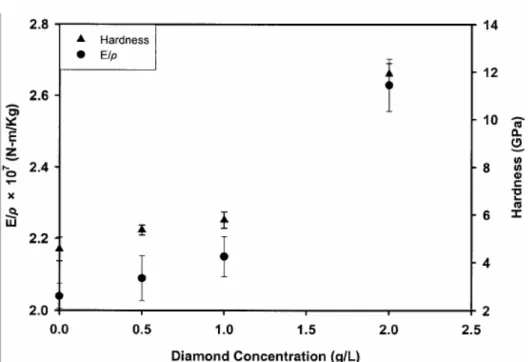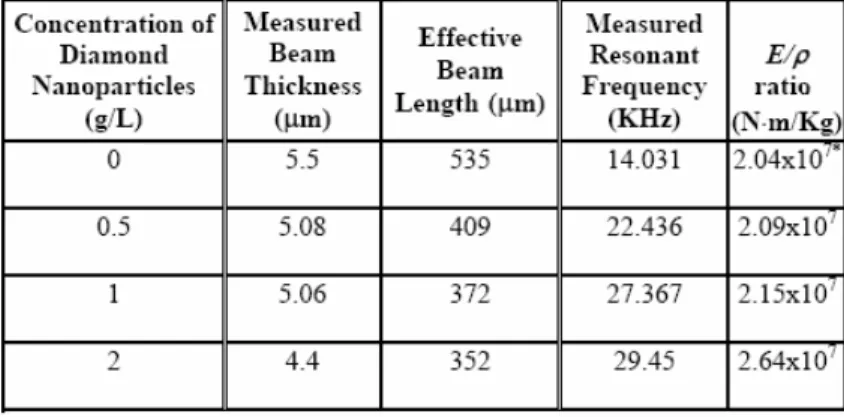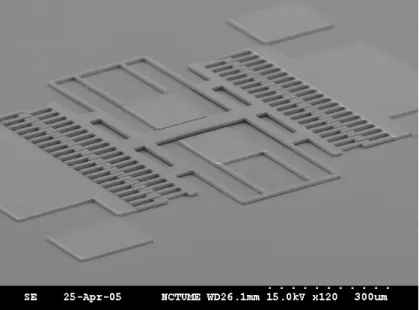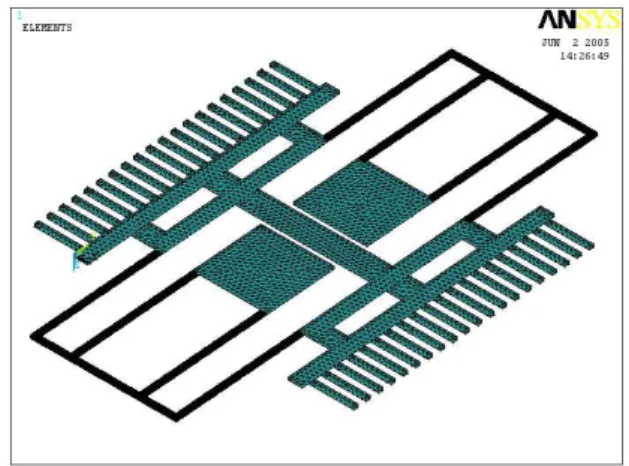執行單位: 國立交通大學機械工程學系(所)
計畫主持人: 徐文祥
計畫參與人員: 蔡梨暖, 李毅家, 黃家聖
報告類型: 精簡報告
報告附件: 出席國際會議研究心得報告及發表論文
處理方式: 本計畫可公開查詢
中 華 民 國 95 年 8 月 9 日
行政院國家科學委員會補助專題研究計畫
行政院國家科學委員會補助專題研究計畫
行政院國家科學委員會補助專題研究計畫
行政院國家科學委員會補助專題研究計畫
□
□
□
□期中進度報告
期中進度報告
期中進度報告
期中進度報告
含奈米粒子之金屬微元件的製程及機械特性研究
計畫類別:■ 個別型計畫 □ 整合型計畫
計畫編號:NSC 94-2212-E -009 -016 -
執行期間: 94 年 8 月 1 日至 95 年 7 月 31 日
計畫主持人:徐文祥
共同主持人:
計畫參與人員:蔡梨暖,李毅家,黃家聖
成果報告類型(依經費核定清單規定繳交):■精簡報告 □完整報告
本成果報告包括以下應繳交之附件:
□赴國外出差或研習心得報告一份
□赴大陸地區出差或研習心得報告一份
■出席國際學術會議心得報告及發表之論文各一份
□國際合作研究計畫國外研究報告書一份
處理方式:除產學合作研究計畫、提升產業技術及人才培育研究計畫、列管
計畫及下列情形者外,得立即公開查詢
□涉及專利或其他智慧財產權,□一年□二年後可公開查詢
執行單位:國立交通大學機械系
中 華 民 國 95 年 7 月 13 日
本計畫重點在探討含奈米鑽石粒子之鎳金屬微結構之材料性質變化及相關應用。在製程上
是藉由低溫、低應力之電鍍製程並於鍍液中添加奈米鑽石粒子(直徑 < 0.5 µm),我們發現
此奈米複材會隨添加鑽石奈米粒子濃度增加而提升硬度及楊式係數,最特別的是還可提升
熱膨脹係數。因此我們以此奈米複材製作電熱式微致動器及梳狀共振器。
在電熱式微致動器部份,鑽石-鎳奈米複合材料減少了元件達相同輸出位移所需得輸入功
率,並提供優於純鎳金屬元件的穩定性。實驗結果顯示, 3µm 的位移輸出下,鑽石-鎳奈
米複合材料降低了純鎳電熱式微致動器 73%的功率輸入;可回復之變形量由 1.8µm 提升至
3µm,經過 100 次的測試,元件仍可恢復至原始位置。在梳狀共振器的部份,鑽石-鎳奈米
複合材料的高楊氏係數使得共振器的共振頻率上升。以含 2g/L 奈米鑽石粒子之電鍍液製作
之梳狀致動器,經頻譜分析後發現,共振頻率提升了 11.4%。
Abstract
In this study, a low-temperature stress-free electrolytic nickel (EL) deposition process with added
dispersed diamond nanoparticles (diameter < 0.5 µm) is developed. It is found that mechanical properties,
such as hardness, Young’s modulus, and coefficient of thermal expansion (CTE), will be enhanced with
the concentration of nano diamond particles. To demonstration the applications of this Ni-diamond
nanocomposite, electro-thermal microactuators and microresonators are fabricated. For electro-thermal
microactuators, device characterization reveals dramatic performance improvements, including a reduction
in the input power requirement and enhancement on operation reliability. In comparison with the
microactuator made of pure nickel, the nanocomposite one can save about 73% the power for a 3 µm
output displacement and have a longer reversible displacement range, which is prolonged from 1.8 µm to
more than 3 µm. Furthermore, the nanocomposite device exhibits no performance degradation after more
than 100 testing cycles in the reversible regime. For the microresonator in comb structure, Ni-diamond
nanocomposite is helpful in enhancing the resonant frequency because of the high Young’s modulus of
Ni-diamond nanocomposite. With 2g/L nanoNi-diamond in the electrolytic nickel solution, an 11.4%
improvement on the resonant frequency is measured from the frequency response analysis.
Introduction
Metal-based micromachining technologies have attracted lots of attentions recently due to their superior
material properities in certain applications, such as RF components and electro-thermal microactuators.
For electro-thermal microactuators, lots of operating principles have been proposed, some of them used
polysilicon as structural materials by silicon-based micromachining process [1, 2], and some used metal as
the structural materials [3, 4].
Comparing with polysilicon, electro-thermally driven microactuators made of metal do not need doping
process, are easier to achieve thicker structure by electroplating, and can provide larger output
displacement with lower input voltage because of larger thermal expansion coefficient. However, the
metal-based microstructure would suffer mechanical deficiency such as fatigue and aging [5, 6]. Also, it
was found out that when operating temperature was higher than certain value, nickel structures would be
degraded and an irreversible darkening on the device surface might occur [7].
Recent research in the nanocomposite synthesis, Teh et al. [8] have proposed the incorporation of
nanodiamond particles into an electroless nickel can greatly enhance the overall stiffness of nickel film due
to the extreme hardness, stiffness, and temperature resistance of the diamond particle [9]. Besides, it was
found that the higher the concentration of nanodiamonds being incorporated into the matrix, the less
residual stress can exits in the composite film, which is very suitable for the fabrication of microactuators.
In order to examine the possibility to employ the low-temperature stress-free electrolytic nickel (EL)
nanocomposite deposition process for future MEMS device applications. Adding the diamond
nanoparticles into the structures could potentially improve and strengthen the material properties. In the
future, Ni-diamond nanocomposite materials could displace polysilicon in certain applications, such as
radio frequency (RF) MEMS metal switches [10] and optical micromirror arrays [11]. In this paper, the
nanocomposite effects on the microactuators, cantilevers and electro-thermal microactuators, will be
further investigated including effects on E/ρratio, hardness, thermal expansion coefficient (CTE), power
consumption, and reversible displacement range.
Characterizations of Nanocomposite Films
Before incorporating a nanocomposite material into MEMS devices, it is important to have a better
understanding of the material characteristics and potential impact on device performance. To facilitate this,
four kinds of as-fabricated 50 µm wide, 6µm thick cantilevers are utilized for the examination of the
material property enhancements in terms of static and dynamic characteristics, such as hardness and
Young’s modulus to density (E/ρ) ratio. The beam lengths are designed as 150 µm, 250 µm, 350 µm, and
450 µm, respectively. Fabrication of the cantilevers is schematically illustrated in Figure 1.
The hardness of the nanocomposite film is characterized by the nanoindenter, XP system of the America
MTS Company. Figure 2 shows the hardness increases with the concentration of the diamond
nanoparticles in a plating bath. The hardness enhancement can be attributed to the incorporation of
diamond nanoparticles. For the case of the nanocomposite film plated with the concentration of 2 g/L
nano-diamonds, it can have 2.6 times larger hardness than the pure nickel one. On the other hand, a laser
doppler vibrometer (LDV) is utilized to characterize the dynamic behavior of
the electroplated films. The E/ρ ratio of the films can be derived from resonant frequencies of the
cantilevers that are made of the EL with different amounts of diamond nanoparticle incorporations. The
relationship between E/ρ ratio and resonant frequency is determined by the following equation (1).
)
L
h
(
/
E
1615
.
0
f
=
ρ
2(1)
where E, ρ, h, and L are the Young’s modulus and density of the structural material and the thickness and
length of the beam, respectively. Since the resonant frequency is very sensitive to the values of h and L,
process variations should be considered for the accurate calculation of E/ρ ratio. Table 1 lists one set of
frequency measurement results of 350 µm long, 50 µm wide cantilevers.
The cantilever fabricated in a plating bath with 2 g/L diamond nanoparticles has about 1.29 times higher
E/ρ ratio than the one made of pure nickel.
Figure 1 Fabrication process flow of cantilevers
Table 1 Measured frequencies of the designed 5 µm thick, 350 µm long cantilevers plated with various Ni-diamond nanocomposites.
Electrothermal Microactuator
The electrothermal microactuator with long-short beam configuration as shown in Figure 3 is used for the experiment. The actuator has a pair of connected cantilevers that are made of the same material but with different actuating arm lengths. In the design, the two beams have a length ratio of 0.5 and a 10 µm gap spacing between them. Both beams have the same width and thickness. The longer beam is about 800 µm long, 10 µm wide and 9 µm thick. Via electrically resistive heating of these two beams, the arm tip curls toward the side of the shorter one due to the unequal thermal expansions of two beams. Fabrication of the electrothermal actuator is similar to that of the cantilevers (described in pervious) with the exception that a 2 µm SiO2 film is used as a sacrificial layer instead. The fabrication result is as shown in Figure 4. Device testing is conducted on a probe station with an automated CCD image system with 0.2 µm resolution. Figure 5 shows the displacement versus input power data obtained from the actuators plated in the baths with different nano-diamond concentrations. The microactuator made of the pure nickel provides a 3 µm displacement with an input power of 0.924 W. Meanwhile, the required input power for the same output displacement decreases with the concentration increase of diamond nanoparticles. It indicates that the microactuator made of nanocomposite is more efficient than the one made of pure nickel. To produce a 3 µm displacement, the microactuator made of the Ni-diamond nanocomposite plated in a bath with 2 g/L concentration of nano-diamond requires only 0.248 W, a 73% reduction in power consumption in comparison with that of a pure nickel device.
An electrothermal microactautor is normally operated in the region of reversible deformation in which the device must come back to its initial position while input power is removed. According to the actuation measurement, we found that the microactuator made of the Ni-diamond nanocomposite has a reversible output displacement over 3µm. In comparison with the pure nickel one, which exhibits irreversible deformation once the output displacement is over 1.8 µm, the nanocomposite actuator can indeed provide a better reversible characteristic. Figure 10 shows cycling test results. The tests are performed on both sets of actuators, which are made of the pure nickel and the Ni-diamond nanocomposite (2 g/L) films respectively, with the operational range from 0 to 3 µm. The hysteretic displacement and surface darkening occur in the pure nickel device during the first cycling test and the device is permanently deformed even after the power is reduced to 0 W. The resting position of the deformed device is 0.2 µm away from its designed origin. In contrast, no hysteresis is found in the nanocomposite device. The back and forth displacements are almost overlapped and no degradation has been found after 100 times cycling tests. The overall results indicate that the electrothermal microactuator made of the nanocomposite not only has better power efficiency but also has enhanced operational reliability by extending the reversible displacement range of the structure.
Figure 4 SEM photograph of the fabricated electrothermal microactuator using Ni-diamond nanocomposite plated with the concentration of 2 g/L nano-diamonds.
Figure 5 Input power versus displacement of the microactuators made of the nanocomposites plated with different nano-diamond concentrations.
Resonator
The three-mask fabrication process, including deposition of the pad layer, the sacrificial layer, and structure mold are proposed to fabrication comb drive. By controlling electroplating parameters which include current density at 1.2
mA/cm2 and operation temperature at 35 ℃, the comb drive made of pure nickel or nickel-diamond nanocomposite can be successfully released without bending, as shown in Figure 6.
The resonant frequency is measured by MEMS Motion Analyzer. This instrument uses both brightfield and interference based illumination modes combined with sophisticated machine vision algorithms to quantify target motions. Under 50V AC with 50V DC bias and the frequency from 5 kHz to 15 kHz, there is a peak for nickel and nickel-diamond comb drive, individually. The results of measurement are shown in Figure 5. The first mode of pure nickel comb drive with 300 µm spring length occurs at 8.034 kHz (Figure 7(a)). The nickel-diamond one resonates at 8.949 kHz (Figure 7(b)). There is an 11.4% improvement in resonant frequency.
Figure 6 no-bending comb drive made by improved process (35 ℃ and 1.2 mA/cm2).
(a) (b)
Figure 7 Measured frequency response of comb drive made by (a) pure nickel (resonant frequency=8.034 kHz); (b) nickel diamond (resonant frequency=8.949 kHz).
Discussions
A low-temperature stress-free electrolytic nickel (EL) deposition process with uniformly dispersed diamond nanoparticles (diameter < 0.5µm) is proposed and successfully demonstrated here. The testing results show that the increasing diamond concentration can effectively enhance E/ρ ratio, rise hardness and increasing CTE.
In the application of electrothermal microactuator, it reduces power requirement of electro-thermal microactuator to achieve the same output displacement. Furthermore, the reversible displacement range of microactuator is also found to be enlarged.
[5] H. C. Nathanson, R. A. Wickstrom, "A Resonant-Gate Silicon Surface Transistor With High-Q Band-Pass Properties", App. Phys. Letters, vol. 7, No. 4, pp. 84-86, 15 Aug. 1965.
[6] Long Que, Lisa Otradovec, Andrew D.Oliver , and Yogesh B.Gianchandani, "Pulse and DC Operation Lifetimes of Bent-Beam Electrothermal Actuators",. The 14th IEEE International Conference on Micro Electro Mechanical Systems, pp. 570-573, Jan 2001.
[7] L. Que, Park, J. S., and Gianchandani, Y. B., "Bent-beam electrothermal actuators—-part 1: single beam and cascaded devices", J. Microelectromechanical systems, vol. 10, no. 2, pp. 247-254, 2001.
[8] K. S. Teh, Y. T. Cheng, and C. Sambucetti, "Selective Plating of Nickel Composite Films For MEMS Applications", Proc.15th Annual Int. Conference on Micro Electro Mechanical System, Las Vegas, NV, USA, pp. 384-387, 2002.
[9] K. S. Teh, Y. T. Cheng, and L. W. Lin, "Nickel Nano-Composite Film For MEMS Applications", The 12th International Conference on Solid State Sensors, Actuators and Microsystems, Boston, pp. 1534-1537, 2003. [10] J. J. Yao, "RF MEMS From A Device Perspective", J. Micromech. Microeng., vol. 10, pp. R9-38, 2000.
[11] G. D. J. Su, MEMS High-Quality Micromirrors For Optical Interconnect and Optical Pick-Up Heads, PhD Thesis, UCLA, CA, USA, 2001.
[12] C. S. Pan and Wen Syang Hsu, "An Electro-thermally and Laterally Driven Polysilicon Microactuator", J. Micromech. and Microeng., vol. 7, pp. 7-13, 1997.
[13] S. Timoshenko, D. H. Young, W. Weaver, Jr., Vibration Problems in Engineering, 4th Ed. New York: John Wiley and Sons, 1974.
[14] W. Riethmuller, W. Benecke, "Thermally Excited Silicon Microactuator", IEEE Trans. Electro Device, vol. 35, pp. 758-763, 1988.
[15] J. H. Comtois, V. M. Bright, "Surface Micromachined Polysilicon Thermal Actuator Arrays and Applications", Technical Digest of the Solid-State Sensor and Actuator Workshop, Hilton Head Island, South Carolina, pp. 174-177, 1996.
[16] Holman, J. P., Heat Transfer, 6thEd., New York: McGraw-Hill, 1989.
[17] C. S. Pan and Wen Syang Hsu, "A Microstructure for in situ Determination of Residual Strain ", J. Microelectromechanical system, vol. 8, pp. 200-207, 1999.
出席國際學術會議報告
會議名稱:2006 年亞太地區傳感器暨奈微米科技研討會
APCOT2006
Asia-Pacific Conference of Transducers and Micro-Nano Technology
時間:2006 年 6 月 25 日至 6 月 28 日
地點:新加坡 Singapore
報告人:交通大學機械系博士班研究生 李毅家
一、會議內容
亞太地區換能器暨奈微米科技研討會(APCOT)為亞太地區所舉辦之
國際研討會,由 2002 年開始,每間隔兩年,由亞洲地區國家輪流舉辦。
此次為第三屆會議,由新加坡主辦。會議於 25 日報到,26 至 28 日
進行會議,每日會議各由 Prof. C.-M. Ho(UCLA)、Prof. T. Laurell (Lund
University)、Prof. H. Fujita (University of Tokyo) 作 Plenary Talk,之後則有
四個 session 同時進行,會議內容主要分為以下主題
01 - Theory, Design, Analysis of MEMS and NEMS
02 - Materials and Device Characterization
03 - Fabrication Technologies
04 - Packaging and Assembly Technology
05 - Mechanical and Physical Sensors
06 - Chemical Sensors and Microsystems
07 - Bio Microsystems and Fluidic Systems
08 - Actuators
09 - Optical MEMS and Nano-optics (PBG, QD)
10 - RF MEMS
11 - Sensing System, Algorithm and Sensor Networks
12 - Nano Devices and Nano Technology
13 - Special Session: MEMS/Nano Technology for Data Storage
14 - Special Session: Power MEMS
15 - Special Session: Nanowire, Nano-structures and CNT
16 - Special Session: Packaging Reliability
本 實 驗 室 在 此 會 議 共 發 表 五 篇 論 文 , 本 人 所 報 告 的 論 文 題 目 是
Performance Enhancement of Comb Drive Actuator Utilizing Electroplated
Nickel-Diamond Nanocomposite,投於Materials and Device Characterization
的session中,報告之內容主要在於陳述以電鍍製作金屬微結構時,加入鑽
石奈米粒子,發現材料性質的變化,利用其中楊氏係數的提升,將之應用
於共振器(梳狀致動器)製作,並使其共振頻率提升。
此次投稿論文報告張貼時間為27日,過程中須由主講者於張貼之海報
旁,並作解說,透過直接面對面的問答,促進彼此之間研究的交流,並且
了解在不同國家,不同學校之間,對於微奈米機所著重的方向,以及研究
的成果。
除了投稿論文報告外,主辦單位邀請了在微機電領域中著名的學者作
Plenary Talk,作為每天會議的開場,並於會議中穿差受邀請教授之專題
演說。除此之外,在報到當天晚上(25日)以及會議開始第二天(27日)晚上
各有Welcome Reception和Dinner Banquet的活動。
三、與會心得
藉由參與此次會議,了解目前在亞太地區各國發展微機電領域的主
流。因應了會議名稱,研究的尺度,由微米朝向奈米推進,所謂朝向奈
米尺度並非只是單純將元件製作至奈米等級,而是研究目前在人力所及
之下,一些奈米尺度的因子對於元件造成的影響,例如奈米粉末對於材
料性質的改變。
各門學科技術,除了學術上的研究外,還必須在產業界能有所應用,
奈微米機電技術也是如此。在奈微米機電技術應用中,最著名的當是加
速規、DLP 以及噴墨頭的,這三者開發至今都有十幾年的歷史,在這十幾
年間,雖然也有其他元件的開發以及應用,但都未能真正帶起奈微機電
蓬勃發展。由三個 Plenary Talk 可發現,目前奈微米機電技術研發的方向
已漸漸朝向分子生物科學以及醫療應用邁進,這說明接下來的奈微米機
電技術的契機將會在生物科技應用上。
感謝國科會補助,讓作者能順利參與此次會議。此會議為作者首次參
加之國際研討會,藉由此次會議,了解國際上奈微米機電的發展狀況,
獲益良多。
四、攜回資料
1. 論文集一本
2. 論文光碟一片
density and operation temperature. Under 1.2mA/cm and 35℃electroplating conditions, it is possible to get the structure with no-bending for pure nickel and nickel-diamond nanocomposite comb drive. It gets 11.4% increase for the first mode resonant frequency.
1. Introduction
For MEMS application, metal has certain advantages over polysilicon, such as high deposition rate, easy stress control, low deposition temperature, and low resistivity. Also by choosing the suitable fabrication process, it is well suited for post processing on preprocessed CMOS wafers.
For further improvement metal properties, Teh et al used the ceramic particles as the additive to electroplate the nickel ceramic composite film in 2002 [2]. It was found that composite film significantly reduced the mismatch of thermal expansion between nickel and silicon. Fortunately, the Young’s modulus, Berkovich hardness, and electrical resistivity were maintained.
After nickel ceramic composite film, Teh et al used diamond and cordierite as the additive [3]. The nickel cordierite microresonator was residual stress free because of the better thermal compatibility with silicon. By adding various concentration of diamond particles, it was found that higher diamond concentration obtained the film with more compressively stress.
In 2003, Tsai et al followed Teh’s research and used nickel-diamond composite as the material of electro-thermal microactuators by electroplating [4]. The E/ρ ratio of microactuators could be enhanced 1.29 times with diamond concentration of 2 g/L. Comparing to device made of electroplated nickel, the electro-thermal microactuators with diamond concentration of 2 g/L could reduce 73% power requirement for 3µm output displacement.
According to the phenomenon in pervious researches, the nano diamond particles can increase the E/ρ ratio of nickel. This property is suitable for resonator made by nickel. Its own resonant frequency can be improved by the nano diamond particles. Here, comb drive is used as the tested device and demonstrating that nano diamond particles can improve the resonant frequency of comb drive made by electroplated nickel. Moreover, it must be concerned that diamond particles cause the compressively stress of nickel film. Therefore, a stress free electroplating process is needed to obtain no-bending comb structure.
2. Fabrication
In the previous test by our group [4], it was found that the E/ρ ratio and hardness increased with the concentration of nano diamond particles as shown in Figure 1. The film with 2 g/L nano diamond particles has about 1.29 times higher E/ρ ratio than the one made of pure nickel. These properties are helpful to calculate the resonant mode of comb drive. By using FEM software, the resonant frequency can be computed easily. 2.1. Dimension and Simulation
The dimensions of comb drive are decided according to the location of the resonant frequency. By using Ansys, the resonant frequency of comb drive is computed easily. The material properties utilized in the simulation follow the results of previous test mentioned before. The model of comb drive by Ansys is shown in Figure 2.
2
Figure 1. E/ρ ratio and hardness with different concentration of diamond nanoparticles.
Figure 2. the model the comb drive by Ansys.
The length of spring is designed from 200 µm to 300 µm. By modal simulation, the fist mode is computed, as shown in Table 1. This table shows that there is about 10.2% improvement of the first mode resonant frequency.
Table 1. FEM simulation of the resonant frequency
Material E (GPa) ρ (kg/m 3) Spring length (µm) 1st mode Resonant frequency (Hz) 300 6804 250 8052 Pure Nickel 190 8908 200 9921 300 7497 250 8872 Nickel- Diamond (2g/L) 230 8882 200 10932 2.2. Process Flow
The process flow is shown in Figure 3. There are five steps in the whole process.
Step1: After RCA cleaning, wet oxide and LPCVD nitride are deposited on the silicon substrate. FH6400 is spun on the wafer and patterned by Mask#1. Sputtered Ti and Ni are lifted off by FH6400. Here, Ti is the adhesion layer and Ni is the pad material.
Step2: FH6400 is spun on the wafer and patterned by Mask#2’ (inverse of Mask#2). Cu is sputtered as the seed layer after hard bake.
Step3: AZ9260 is spun on the wafer and patterned by Mask#3. This AZ9260 layer is the mold of the Ni electroplating.
Step4: Ni and Ni-Diamond are electroplated by using the Cu as the seed layer. The diamond concentration is about 2 g/L in the electroplating solution.
Step5: AZ9260 and Cu seed layer are removed by ACE and the solution of ammonia plus hydrogen peroxide individually. Here the etching of the Cu seed layer must be well control. The structure may peel off because of the over etching. The FH6400 sacrificial layer is removed by PR stripper. At last, the sample is baked dry after IPA immersion.
3 structure by reducing the current density. Under the current density less than 1 mA/cm2, the deposition rate is too slow. It makes the fabrication process inefficiently. So it is necessary to find another way to solve the stress problem.
Under operation temperature test, it is found that reducing the operation temperature is also helpful to solve the stress problem. Maintaining the current density at 1.2 mA/cm2 and reducing operation temperature, it is found that comb drive can be free standing with electroplating temperature at 35 ℃. The free standing comb drive is shown in Figure 4(b).
(a)
(b)
Figure 4. (a) comb drive ade by original process (50 ℃ and 10 mA/cm2). (b) no-bending comb drive made by improved process (35 ℃ and 1.2 mA/cm2).
resonant frequency.
(a)
(b)
Figure 5. Measured frequency response of comb drive made by (a) pure nickel (resonant frequency=8.034 kHz); (b) nickel diamond (resonant frequency=8.949 kHz).
4. Discussion
Controlling the electroplating conditions under 1.2mA/cm2 and 35℃, it is possible to get the structure
4 with no-bending for pure nickel and nickel-diamond nanocomposite comb drive. By the test, it is found that there is an 11.4% improvement in resonant frequency. This value is close to 10.2% which is gotten by simulation.
The mismatch of the first mode resonant frequency between simulation and measurement may result from the fabrication control ability. For example, the geometry of the PR mode, the sidewall of the PR mold is not easy to control as a perfect vertical sidewall. It results in the geometry mismatch between simulation and experiment.
Except the geometry problem, the unstable of material properties is another issue. It seems that different run obtains different material properties. The deviation of the material properties between different run may be caused from the quality of electroplating solution. Although it is unstable in material properties, the Young’s modulus of nickel-diamond is always larger than nickel’s.
Acknowledgements
The authors would like to express the appreciations to Nano Facility Center of National Chiao Tung University and National Chip Implementation Center for the support of the fabrication and measurement instruments. This work is supported by the project of National Science Council, NSC 94-2212-E-009-016.
References
1. A.D. Yalcinkaya, J.T. Ravnkilde, L.S. Johansen, O. Hansen, Proceedings of TRANSDCUCERS '01,600, (2001)
2. Kwok-Siong Teh, Yu-Ting Cheng, and Carlos Sambucetti, Proc. 15th Annual Int. Conference on MEMS, Las Vegas, NV. USA,384-387 (2002) 3. Kwok-Siong Teh, Yu-Ting Cheng, and Carlos
Sambucetti, Conference on Solid State Sensors, Actuators and Microsystem, 1534-1537 (2003) 4. Li-Nuan Tsai, Guang-Ren Shen, Y-T Cheng,
Wensyang Hsu, Journal of MEMS, 15, 149-158 (2006).





